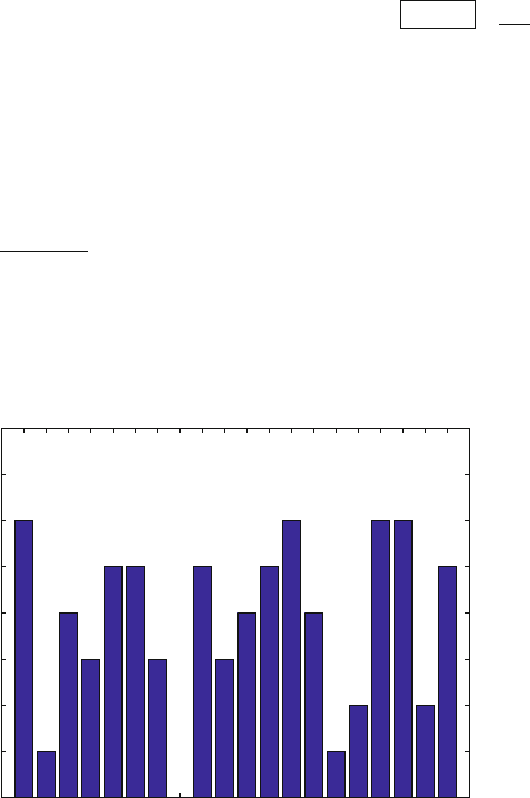Schlick T. Molecular Modeling and Simulation: An Interdisciplinary Guide
Подождите немного. Документ загружается.


586 Appendix D. Homework Assignments
BDL078 PDR010 PDT034
μσ μσ μσ
P
χ
α
β
γ
δ
ζ
Ω
τ
ρ
ω
RMSD
(d) Are any of the changes observed localized to particular regions in the
DNA? (Consider properties with μ values similar to B-DNA but large
associated σ values). Plot one
of these parameters as a function of
position (base pair) along the DNA.
(e) Generate a side-by-side picture of the three DNA structures. A recom-
mended utility for this is the
File / Export Plot facility.
3. Analysis of Interface Between Proteins and DNA. Next, we will examine
some of the interactions formed at the interface between the regulatory pro-
teins and their DNA binding sites. Load the PDB files of each DNA/protein
complex in turn and unmerge the DNA part (but leave the DNA and protein
together in space).
The main tool used here is the
Subset / Interface pulldown in the central
Viewer module. This menu allows subsets to be defined in one molecule
that satisfy a certain spatial relationship with respect to the other molecule.
For example, we would like to use this menu to define subsets of atoms in
the protein that are near functional groups of the DNA. A contour level of
3.5
˚
A is useful in this menu for defining interactions between non-hydrogen
atoms, since it roughly corresponds to distances for strong interactions.
Open the
Subset / Interface pulldown menu. You can define the Subset
Name as you please. You can define the Center of Subset tobeaspecific
functional group in DNA. For example, DNA:T:C5M refers to atom C5M
of thymine’s methyl group in the DNA. Define the Search
Domain to be
the protein. The Radius of Subset should be set to the value 3.5.
For your reference, these are names of some DNA atoms:
• Phosphate groups: Atoms P, O1P, O2P
• Thymine methyl groups: Atom C5M

Appendix D. Homework Assignments 587
• Adenine amino groups: Atom N6
• Pyrimidine carbonyls: Atom O2
• Purine amines: Atom N3
(a) Save listings of these subsets into output files.
Subset / List is
recommended for this task.
[Do not be alarmed if you get the error message “Invalid Com-
parison Object”; it simply means that the comparison could not be
performed since no member of the set fulfilled the criteria. If an at-
tempt is made to analyze all atoms B that are 3.5
˚
A from protein A,
but all atoms of protein A aremorethan3.51
˚
A from B, this error
will occur.]
Combine the analyses of the two complexes (if you can) and construct
histograms
of the residue types in each subset. That is, from the list-
ings of all residues within 3.5
˚
A of the atom groups above, count the
number of times each residue appears (e.g., Methionine appears 60
times, Glutamate 3) and generate histogram plots as illustrated be-
low; use the one-letter mnemonic for the amino acids. (You may also
want to count the frequencies of residues grouped by type, like polar,
hydrophobic, charged, etc.).
A C D E F G H I K L M N P Q R S T V W Y
0
1
2
3
4
5
6
7
8
Phosphate Interactions
Figure D.1. Sample histogram for protein/DNA interaction analysis.
(b) Do you observe common patterns in the two complexes? Are certain
amino acids likely to be found interacting with a particular functional
group? What types of interactions are being formed between these nu-
cleic acid functional groups and the regulatory protein (e.g. attribute
to each of the nucleic acid groups above a type of interaction such as

588 Appendix D. Homework Assignments
hydrophobic, hydrogen bonding, electrostatic, intercalation/insertion
motif, etc.)?
(c) Is there anything unusual about the subsets formed between the
proteins and the O2 carbonyl/N3 amine atoms?
(d) Is there any relation between the interactions observed in these subsets
and the deviations from canonical B-DNA structure observed above
(i.e. how do the interactions you observe explain any of the parameter
variances you diagnosed)?
Note: A trick to identify atoms/residues is via
Molecule / Color for
assigning a color to an atom/residue. Other labeling tools such as
Molecule / Render and Molecule / Label can similarly be used.
(e)
Bonus Question:
4
BDL078 Homologues. We have used the
BDL078 structure as an example of B-DNA in the analysis above.
However, sequence-dependent variations in local structure are also
important. Therefore, a more sensitive analysis of free versus pro-
tein/bound DNA employs the same
nucleotide sequence, both with
and without bound proteins. There are few cases, however, in which
high-resolution DNA structures are available in both the free and
protein-bound states. Such analyses are illuminating and show how
intrinsic DNA preferences are amplified in the DNA/protein com-
plexes. See recent reports regarding the complex between DNA and
the bovine papillomavirus E2 protein in D.M. Crothers (Proc. Natl.
Acad. Sci. 95:15163–15165, 1998) and H. Rozenberg et al. (Proc.
Natl. Acad. Sci. 95:15194–15199, 1998).
Such analyses have not been done with our BDL078 sequence, but
there are protein-DNA complexes in the NDB which are closely re-
lated to BDL078. This close relationship means that: (i) the related
sequence has many similar or closely related residues to BDL078
(e.g., GGGAAAATTT is closely related to GGCATAACTT), and
(ii) the protein would bind to BDL078 and this related sequence.
Determine which protein/DNA complexes these are, and briefly
describe what these complexed proteins do.
Background Reading from Coursepack
• K. B. Lipkowitz, “Abuses of Molecular Mechanics. Pitfalls to Avoid”, J.
Chem. Educ. 72, 1070–1075 (1995).
• S. Lifson, “Potential Energy Functions for Structural Molecular Biology”,
in Methods in Structural Molecular Biology, pp. 359–385, D. B. Davies,
W. Saenger, and S. S. Danyluk, Eds., Plenum Press, London (1981).
4
The correct solution will allow you to drop lowest homework grade in any assignment.

Appendix D. Homework Assignments 589
Assignment 6: MIDTERM: Homology Contest!
Exploring Sequence/Structure/Function Relationships
(& Related Tools/Databases like SCOP, IMAGE,
BLAST, NDB, PDB)
With the rapidly growing information on genomic sequences, comparative
modeling — structure prediction based on sequence similarity — is becoming
increasingly valuable. Indeed, structural and functional genomics, the three-
dimensional (3D) structure and functional analysis of genomic products, are rising
disciplines in bioinformatics. It has been reported, for example, that a sequence
homology of larger than 40% usually implies more than 90% 3D-structure overlap
(see below for precise definitions of similarity). Thus, with the growing amount
of genomic information, we may eventually be able to predict reliably 3D struc-
tures of proteins. Since structural similarity is often preserved more strongly than
sequence through evolution, reliable homology-based predictions might provide
crucial functional properties of new gene products in the near future.
Through this assignment, you will gain some experience in quantifying and an-
alyzing sequence and 3D structure similarity for proteins. You will also explore
sequence and structure databases in search of interesting examples, and learn how
to use important computational and database resources. You will have to be re-
sourceful in looking for suitable programs for alignment and structure analysis
besides those below; no simple recipes will be given here.
This assignment can be done by teams of two students; choose a partner with
complementary skills. You will have to present your results to the class.
The 5 Tasks
Find and demonstrate the following four relationships for proteins:
1. [EASY] Two proteins with very high sequence similarity (but less than
95%) and very high structural similarity. Excluded from consideration
are trivial examples, such as involving multiple PDB entries for the same
protein.
2. [EASY] Two proteins with very high sequence similarity (but less
than 95%) and
very high structural similarity but markedly different
biological/functional properties.
3. [MODERATE] Two proteins with low sequence similarity but high
structural similarity. Also comment on the functional properties of the pair.
4. [HARD] Two proteins with very high sequence similarity but very low
structural similarity. Also comment on the functional properties in your
example.
For problems 3 and 4 above, the class contest will
be won by the students that find the most extreme

590 Appendix D. Homework Assignments
examples (i.e., the maximal sequence similarity /
minimal structural similarity, minimal sequence sim-
ilarity / maximal structural similarity).
5. [EASY WARMUP] Search and identify all the determined
structures in the PDB/NDB that contain the nucleic acid
sequence TATAAAAG. Discuss these structures and their significance.
For each task, generate color molecular views, report
the analyses in detail, and include a description of
how you found the example. Also discuss your similar-
ity/dissimilarity criteria (see below), and prepare a class
presentation on your results.
Ground Rules
1. Homology, or sequence similarity, will be defined by the percentage of
sequence identity.
2. 3D-structure similarity will be defined in two ways:
(a) the percentage of C
α
atoms of the proteins that “overlap”, i.e., are
within 3.5
˚
A of each other in a rigid-body alignment of the protein;
(b) the root-mean-square-deviation (RMSD) between C
α
atoms of the
proteins in a rigid-body alignment of the protein. (Recall your
experience with RMSD measurements in the previous assignment).
You should first experiment with overlapping several protein structures to
determine what RMSD values and/or percentages of C
α
overlap indicate
random similarity. Discuss this in your submission.
Tools of the Trade
1. Sequence and Structure Databases. You have already navigated through
the structural PDB and NDB databases and various sequence databases.
Continue to work with these and the RCSB facilities.
2. SCOP. This site for the Structural Classification of Proteins
(scop.mrc-lmb.cam.ac.uk/scop/ categorizes proteins according to the
levels (top-to-bottom) of: class, fold, superfamily, family, domain, and
reference PDB structure.
3. Insight II. Continue to use Insight II for structure display and analysis.
4. NCBI Tools like BLAST and Its Cousins. BLAST is a library of heuris-
tic similarity search programs (Basic Local Alignment Search Tools) that
explore relationships involving protein and nucleic-acid sequences and 3D
structures. This library contains blastp, blastn, blastx, tblastn, tblastx,
Appendix D. Homework Assignments 591
and others, developed at the National Center for Biotechnology Informa-
tion at the National Library of Medicine of the National Institutes of Health.
Get started at their web site www.ncbi.nlm.nih.gov/BLAST/.Thispage
leads to the BLAST suites as well as contains usage information. See, for
example, Overview, Manual, BLAST FAQs, References.
BLAST, one of the most popular tools among molecular biology re-
searchers, has evolved rapidly since its inauguration in 1990. BLAST
searches a database in two stages, finding small sequence lengths that
match the target exactly and then attempting to extend the length of the
match from this subset of sequences in the database. Not only are the
alignment algorithms improving continuously (e.g., allowing alignments
of DNA or protein sequences with insertions or deletions in Gapped
BLAST; forming families of aligned sequences and quick profiles of them
in Position-Specific Iterated (PSI)-BLAST; or incorporating biological-
function hypotheses into sequence queries to restrict the analysis to subset
of protein sequences as in Pattern-Hit Initiated (PHI)-BLAST), but perfor-
mance has been greatly accelerated. Algorithmic features include dynamic
programming tools, hidden Markov models, and various optimization
strategies.
To align two protein or nucleotide sequences, go to the link of BLAST 2
sequences (www.ncbi.nlm.nih.gov/gorf/bl2.html) and set up the compu-
tation according to the instructions. Take care to choose the options of the
computation with care, and explore different options. The server will send
the results to the web browser being used.
Some available programs are:
blastp: compares an amino acid query sequence against a protein sequence
database.
blastn: compares a nucleotide query sequence against a nucleotide sequence
database.
blastx: compares the six-frame conceptual translation products of a nucleotide
query sequence (both strands) against a protein sequence database.
tblastn: compares a protein query sequence against a nucleotide sequence
database dynamically translated in all six reading frames (both strands).
tblastx: compares the six-frame translations of a nucleotide query sequence
against the six-frame translations of a nucleotide sequence database.
See www.ncbi.nlm.nih.gov/BLAST/newblast.html#introduction for fur-
ther information.
Other similarity programs are available (such as MEME and
MAST from SDSC); use anything appropriate for the task.
5. An Image Library.TheImage Library of Biological Macromolecules or-
ganized by the Institute for Molecular Biotechnology in Jena, Germany
(www.imb-jena.de/IMAGE.html) offers a colorful library of biomolecu-
lar images corresponding to structures available in databases like the NDB

592 Appendix D. Homework Assignments
and PDB. Besides detailed colorful illustrations of the structure in a variety
of styles, relevant structural information and publication links are available.
Basic tutorials on structural biology are under preparation at this site.
HINTS for the Assignment
1. Scan the literature for related papers on comparative or homology modeling
but do not repeat known examples. You CAN be original.
2. Large changes in 3D structure despite high sequence similarity can result
from the following situations:
• mutations in critical regions of the proteins such as active sites
• mutations in ligand binding sites (as in immunoglobulins)
• mutations in regions that connect two secondary-structural elements
(as in helix-loop-helix motifs)
• structure determination of the same system at different environmental
conditions (e.g., different solvent, different crystal packing forms for
mutant proteins)
• proteins containing the same subunits but a different number of sub-
units, with a structure/fold/topology that depends critically on that
number.
Search PDB and SCOP for examples in this spirit.
3. Look for groups of proteins in the same family, or for proteins sharing
the same fold in the SCOP site. The structural classification information
should generate ideas.
4. General structure alignment via Insight is not very sophisticated and
may be entirely unsuitable for sequences of disparate lengths and for
structures with two similar subdomains adopting a different relative orien-
tation. Search for suitable programs for these cases (e.g., from the RCSB,
home.rcsb.org and from SDSC) and also write/use your own programs to
perform certain analyses, such as structure similarity measurements upon
alignment (e.g., criterion 2a under Ground Rules).
Background Reading
• D. Baker and A. Sali, “Protein Structure Prediction and Structural Ge-
nomics” Science 294, 93–96 (2001). [From Coursepack].
• J. C. Whisstock and A. M. Lesk, “Prediction of Protein Function from Pro-
tein Sequence and Structure”, Quart. Rev. Biophys. 36, 173–189 (2001).
[From Coursepack].
• J.-M. Chandonia and S. E. Brenner, “The Impact of Structural Genomics:
Expectations and Outcomes”, Science 311, 347–351 (2006). [From
Coursepack].
Appendix D. Homework Assignments 593
• B. Honig and A. Nicholls, “Classical Electrostatics in Biology and
Chemistry”, Science 268, 1144–1149 (1995) [From Coursepack].
• D. Case, “NMR Refinement”, in P. von Ragu´e Schleyer (Editor-in Chief),
N. L. Allinger, T. Clark, J. Gasteiger, P. A. Kollman, and H. F. Schaefer,
III, editors, Encyclopedia of Computational Chemistry, volume 3, pages
1866–1876. John Wiley & Sons, West Sussex, England, 1998.
594 Appendix D. Homework Assignments
Assignment 7: Molecular Mechanics Force Fields:
Approximations, Variations, and the Assessment
of Results with respect to Experiment and other
Simulations
1. Reading. This assignment deals with the series of four articles below,
which raise both general and specific problems in biomolecular simula-
tions. At issue is the validation of conformational predictions by various
molecular mechanics force fields. You may also wish to refer to the
Lipkowitz article from Assignment 5 (on the pitfalls of molecular me-
chanics) and the van Gunsteren and Mark article from Assignment 1 (on
validating molecular dynamics simulations). Begin by reading these pa-
pers (included in the Coursepack, see Appendix B) and thinking about the
modeling issues as you read them.
• I. K. Roterman, M. H. Lambert, K. D. Gibson, and H. A. Scheraga,
“Comparison of the CHARMM, AMBER and ECEPP Potentials for
Peptides. I. Conformational Predictions for the
Tandemly Repeated Peptide (Asn-Ala-Asn-Pro)
9
”, J. Biomol. Struct.
Dyn. 7, 391–419 (1989a).
• I. K. Roterman, M. H. Lambert, K. D. Gibson, and H. A. Scheraga,
“Comparison of the CHARMM, AMBER and ECEPP Potentials for
Peptides. II. φ–ψ Maps for N
´
-Methyl Amide: Comparisons, Contrasts
and Simple Experimental Tests”, J. Biomol. Struct. Dyn. 7, 421–453
(1989b).
• P. A. Kollman and K. A. Dill, “Decisions in Force Field Development:
An Alternative to Those Described by Roterman et al.”, J. Biomol.
Struct. Dyn. 8, 1103–1107 (1991).
• K. B. Gibson and H. A. Scheraga”, “Decisions in Force Field De-
velopment: Reply to Kollman and Dill”, J. Biomol. Struct. Dyn. 8,
1109–1111 (1991).
2. Preparation for Class Discussion. You will be divided into three groups
(assignments will be given in class): (1) the moderators, (2) the ECEPP
group, and (3) the AMBER and CHARMM group. Each group will have to
prepare material, as described below, for class presentation and discussion.
All materials should be prepared on overhead projector slides. You should
meet with your group members in advance to plan your presentation and
debate strategies.
The moderators will be in charge of presenting in detail the facts:what
studies were performed, what questions were asked, and what anal-
yses were made. You should be prepared to answer any background
questions (e.g., definitions of polymer quantities analyzed).
Appendix D. Homework Assignments 595
The ECEPP group will endorse the point of view taken by Roterman,
Gibson, Scheraga, and co-workers. Besides understanding your po-
sition well, you will need to bring to the debate concrete examples
from the literature to support your position. Be creative and try to find
interesting examples.
The AMBER folks and CHARMMers will endorse the approach taken in
these two molecular packages and, in particular, the point of view
taken by Kollman and Dill in their reply to Roterman et al. As above,
besides understanding well your molecular mechanics packages and
position taken in the reply, you will need to bring to the debate con-
crete examples from the literature to support your position. Be creative
in your supporting materials and strategies.
3. Useful Recommendations. Summarize in brief the useful recommenda-
tions and comments that emerged from all the above articles, as well as
additional ones, for practitioners of molecular modeling. That is, propose
concrete procedures that biomolecular simulators can use to gain as much
confidence as possible in their conclusions and predictions.
Remember, uncertainties and approximations in numerical mod-
eling and simulations will always exist! The field of modeling
biomolecules on modern computers involves as much art as
science. But despite their obvious limitations, modeling method-
ologies are improving continuously. The goal of every practi-
tioner should be to realize the highest possible accuracy as is
compatible with the model and methods utilized. Like any cal-
culation, ‘error bars’ in the broad sense should be attributed to
the results and conclusions claimed.
4. Points to Keep in Mind. Throughout this assignment, think about the
following important issues in molecular modeling:
• Accuracy versus approximation
• Theory versus experiment
• Dependence of simulation results on the protocols used
– starting configuration
– model assumptions
– force field
– algorithms (minimization, adiabatic mapping, etc.)
• Assessment of Results:
– How can you distinguish between bona fide physical trends and
numerical artifacts?
– How can you decide whether the model is wrong (energy,
assumptions, etc.) or the method is inappropriate?
– What are appropriate comparisons with experimental results?
